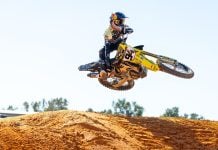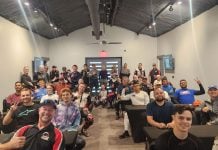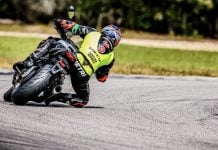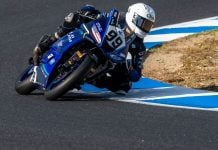HONDA’S DOUBLE CENTURY MAKES HISTORY It’s appropriate that Honda has scored its 200th premier class Grand Prix race win during an era when anything in the 200 range is particularly in vogue. The latest all-conquering Honda MotoGP machine, the 990cc RC211V Vee-five, is well into 200bhp territory, and easily capable of reaching a terminal tarmac velocity of over 200mph should the need ever arise. To the uninitiated Honda’s own unique senior class ‘double-ton’ reached at Assen, Holland by American Nicky Hayden riding for the Repsol Honda factory team, may seem to have been a long time in the making. If, however, you consider that Honda only entered the premier class for the first time in 1966, and from the end of 1967 season until 1982 Honda’s early 500cc GP winning ways were curtailed, a different and even more impressive context is placed on the latest Honda racing landmark. 200 wins, in less than effectively – 27 years. Suguru Kanazawa, President and Director of Honda Racing Corporation said: “I would like to thank Nicky for today’s victory, Honda’s 200th World Grand Prix win in the “Premier” class. This is an historic day for Honda – we entered the first race on May 22 1966 in West Germany and won the debut race. The circuit may be different but this is the 40th anniversary for us racing in the highest class of racing so we especially happy to achieve this victory now. We would also like to extend our gratitude to all of the riders, teams and our partners in those 40 years who have all contributed to reaching this landmark. We will continue to challenge the technological barriers to achieve world titles and we look forward to many years of participation in the future.” Honda is, indeed, as quick with the statistics as it is with the machinery, and is the first manufacturer to reach the unique total of 200 MotoGP wins. The next nearest challenger is over 50 wins shy of the magic double ton, at the present time. The first two years of full factory Honda involvement in 500cc Grands Prix only came to pass after winning every imaginable honour in the smaller 50, 125, 250 and 350cc categories. Rhodesian Jim Redman, a proven champion in the middleweight categories for Honda, was chosen as the man to take on the biggest of all racing worlds. A daunting task, it may have seemed, but he still won the four-cylinder RC181 its first ever 500 GP, at Hockenheim, West Germany (by some 26 seconds, no less) on May 22 1966. The Redman/RC181 pairing also triumphed at the next race at Assen, before a heavy crash at the fearsome Spa-Francorchamps circuit ended his season prematurely. Redman was immediately replaced by the ever-rising brilliance of former 500 champion Mike Hailwood for the remainder of ’66, but despite winning three of the seven available races, he did not win the championship itself. The combined efforts of Redman and Hailwood, and the remarkable air-cooled in-line-four cylinder RC181 did, however, deliver the 500cc Constructors’ Championship to Honda at the first time of asking. In the following year, Hailwood tied with Agostini on points, but on count-back, Hailwood and Honda lost out on their much-desired crowns. Nonetheless, another five race wins accrued towards the current 200. After some brave experimentation with the oval-pistoned NR500 four-stroke project (which was, however, to prove prescient in terms of future MotoGP racing formulae) the first ever two-stroke Honda 500 GP machine was such an instant success in 1982 that Honda did not take long to get on the winning trail once more. Conventional wisdom says that the more cylinders the better, and even Honda’s early four-stoke racers adhered to that edict with an array of immaculately conceived fours and sixes. Never ones to tarry too long on the safe side of the leading edge, however, Honda realised that a manoeuvrable, light and relatively torquey three-cylinder two-stroke would be more than a match for everyone else’s fours, over a season at least. Enter the water-cooled NS500. In its debut race in the top class, Freddie Spencer scored third in Buenos Aires, took pole in race three at Jarama, and took his and the NS500’s first GP win at Spa Francorchamps, round 7. Spurred on by this success, Takazumi Katayama notched up a win at Anderstorp, Sweden, as Spencer added another at the San Marino GP held at Mugello, Italy. In 1983 Honda and boy wonder Spencer fulfilled their own inevitable prophecies and won the biggest crown of all, the Riders’ World Championship. Honda added a Manufacturers’ crown to their first from 1966. Spencer had scored a super-six race wins to beat Kenny Roberts and Yamaha, in one of the best man-to-man fights in all of GP history. As 1984 was ushered in the Manufacturers’ title was retained, but in a whole new era for Honda’s expansive engineering vision, race wins came as a result of two machines; the latest NS500 triple and the radical four-cylinder NSR500 vee-four, with Spencer and eventual second place man Randy Mamola swapping race wins, and outings on either triple of four. Eight race wins overall (five for Freddie and three for Randy) even if he Riders’ title was lost, but not for long. In 1985 Spencer took his second and Honda’s second World Championship (scooping the small matter of the 250 crown along the way) easing to seven wins (on a heavily revised NSR) to Mamola’s one (on an NS). The very next new kid on the block, Wayne Gardner, scored three wins in 1986, before taking the riders title for Rothmans Honda in 1987, winning another seven. Four more in 1988 for Gardner, very much in Rothmans Honda colours still, were not enough to keep the title. With former Freddie guru Erv Kanemoto at the pit garage helm for new-signing Eddie Lawson – long a thorn in Honda’s side the championship was his for the taking, as he battled his way to four race wins, the Riders’ title and, with Gardner and Pierfrancesco Chili’s singles, the Manufacturers’ crown came back again. A barren spell for titles in the early nineties was not without wins for Honda riders, as Gardner scored two in 1990 and one in 1992. There was another Aussie making a name for himself though, and it was to be the name ever in Honda’s premier class colours, Mick Doohan, who would score a career total of 54 race victories on the all-conquering NSR500. Honda had frequently supplied top private, importer or satellite teams with good equipment in the early two-stroke era, but when Alex Criville scored a race win at Assen for the Fortuna Honda squad, Honda’s lease policy for factory equipment really proved its worth and it has been doing so ever since. A largely barren 1993, with only one win each for Mick Doohan and Daryl Beattie. Long-time sponsor Rothmans made a strategic switch to F1 in 1994 while Mick Doohan went on to take an incredible nine wins riding in Honda colours. He would take the title for five years straight, as Honda retained the manufacturer’s award with equal regularity. From 1994 to his enforced retirement after injury during 1999, Mick was the man to beat and frequently the only people who could were his fellow Honda riders, in full factory and lease teams. Alberto Puig (Fortuna Honda) joined a growing band of Spanish race victors, in 1995. In 1996 Mick scored eight wins, Criville two, with Italian ace Luca Cadalora also taking two for Kanemoto. Carlos Checa also scored his maiden win, for the Fortuna Honda squad. In the ’97 season Tady Okada was a third Repsol Honda rider, and earned two wins to Criville’s single, but again Doohan was the powerhouse, with Mick taking 12 of Honda’s 15 race victories. In the last year of his MotoGP domination, Mick raced to eight wins, Criville two and Tady Okada took a single. Checa scored another (this time for Movistar) and the abilities of the ever-improving NSR even allowed one Max Biaggi, riding for Kanemoto on a Marlboro Honda, to win his debut MotoGP race, Suzuka. After the exit of Doohan the floodplains of opportunity were filled by new champion Criville, winning six 1999 events to Okada’s three, and the Manufacturers’ crown once more went to Honda. The New Millennium may have come a little too early for the rising sun and moon of Valentino Rossi to win in his debut 500 year, but Honda’s lease scheme proved its value yet again, as factory rider and reigning champion Criville scored only a single win, but Alex Barros (Emerson Honda) and Rossi (Nastro Azzuro Honda) waded in with two apiece, as Loris Capirossi (Barros’ team-mate) took one other. The beginning of the end of the two-stroke era, with its last full grid of 2-strokes in 2001, provided a glorious exit for the NSR500, and a glorious entry for Rossi into the list of champions. Eleven wins later (plus another NSR triumph for West Honda satellite rider Barros) and Honda were Manufacturers’ champions again. With racing technology coming full circle back to four-strokes, and making a leap from 500cc to 990cc in 2002, Honda and Valentino Rossi won their respective titles. The RC211V five-cylinder 990cc four-stroke had a winning debut at Suzuka in the Hands of Rossi (now in factory Repsol colours). Eight wins on, plus a single for Repsol rider Tohru Ukawa and two for West Honda’s Barros, and the new four-stroke golden age was proving to be Honda-shaped. In 2003 Rossi stormed the ramparts with his RC211V once more, taking nine wins, but he was far from alone in challenging for top honours. Sete Gibernau scored second overall, and ripped four wins from Rossi’s grasp, on his Telefonica machine in the Gresini squad. Max Biaggi’s Camel machine took full points in the UK and at Motegi, ensuring that the Manufacturers’ crown stayed with Honda. Although Rossi’s move to Yamaha in 2004 gave him the first of two consecutive Riders’ Championships, that first year’s Manufacturers’ crown stayed with Honda, thanks to Gibernau’s four wins, two for Camel rider Makoto Tamada and one for his team-mate, Biaggi. Tamada was only the first of a solid wall of riding talent Honda was to draw on for the 2005 season, as RC211V wins went to three different Honda riders, in a field featuring seven RCs. Barros gave the Camel Honda team a victory in Portugal but the new Honda kids were coming, and they had teeth and claws. Official Repsol factory Honda squad rider Nicky Hayden took a popular win at the US GP and the season was ended in stunning fashion by Marco Melandri (Telefonica/Gresini) with two race wins. Honda’s continued policy to provide lease machines to high quality teams continues to this day, and in 2006, the story has been one of youth stepping up to the challenge. Melandri, now with Fortuna sponsorship on his HRC lease machine, has taken two wins, the latter the precursor to Honda’s 200th. Without the stunning season start of rookie Dani Pedrosa (Repsol Honda) Melandri would only have scored win 198 at Le Mans, not the 199 that set up today’s celebration of a unique achievement. On the five-year-old RC211V, youth is having its day, and with new 800cc machines on their way in 2007, yet another alloy and carbon fibre Honda rookie will be unveiled, to carry on the march towards 300 MotoGP wins. Highlights from Hondas 500cc MotoGP History 1966: Honda make debut in 500cc World Championship. RC181 in-line four-cylinder air-cooled four-stroke. Jim Redman races RC181 to debut victory at West German Grand Prix Hockenheim. Mike Hailwood wins Senior TT. Honda wins Manufacturers Championship. 1967: Mike Hailwood wins Senior TT. 1982: Honda returns to 500cc World Championship. NS500 V three-cylinder water-cooled two-stroke. Freddie Spencer races NS500 to third place in debut race at Argentine Grand Prix, Buenos Aires Spencer and NS500 win Belgian Grand Prix Francorchamps. 1983: Freddie Spencer 500cc World Champion NS500 Honda the Manufacturers World Championship 1984: Honda introduce NSR500 V four-cylinder water-cooled two-stroke with radical fuel tank under engine design. 1985: Freddie Spencer 500cc World Champion NSR500 Honda the Manufacturers World Championship 1987: Wayne Gardner 500cc World Champion on NSR500. 1989: Eddie Lawson 500cc World Champion on NSR500. 1992: Honda regains 500cc Manufacturers World Championship. 1994: Michael Doohan and Honda NSR500 score first of five-consecutive rider and Manufacturers World Championships. 1999: Alex Criville and Honda NSR500win rider and Manufacturers World Championships. 2001: Valentino Rossi and Honda NSR500 win final 500cc World Championship titles. 2002: Honda introduce RC211V five-cylinder liquid-cooled 990cc four-stroke grand prix machine. Valentino Rossi and RC211V win rider and Manufacturer World Championships. 2003: Valentino Rossi and RC211V win rider and Manufacturer World Championships. 2004: Honda wins Manufacturers World Championship RC211V 2006: Honda and Nicky Hayden record 200th 500cc-MotoGP victory. Winning Honda riders: 54 – Mick Doohan 33 – Valentino Rossi 20 – Freddie Spencer 18 – Wayne Gardner 15 – Alex Criville 8 – Sete Gibernau, Mike Hailwood 6 – Alex Barros 5 – Max Biaggi 4 – Eddie Lawson, Randy Mamola, Marco Melandri, Tady Okada 2 – Luca Cadalora, Carlos Checa, Jim Redman, Makoto Tamada, Nicky Hayden. 1 – Daryl Beattie, Loris Capirossi, Pier-Francesco Chili, Takazumi Katayama, Dani Pedrosa, Alberto Puig, Tohru Ukawa.
Honda Celebrates 200th Premier Class Grand Prix Victory
Honda Celebrates 200th Premier Class Grand Prix Victory
© 2006, Roadracing World Publishing, Inc.






